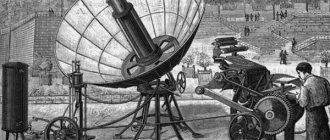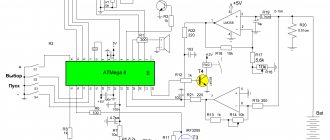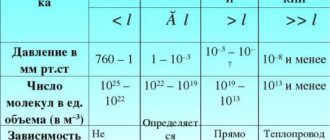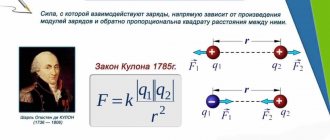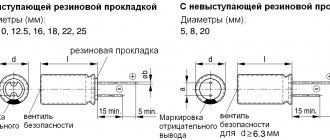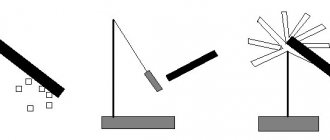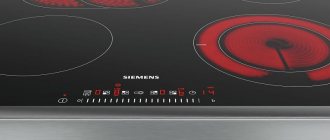Energy in physics
Kinetic and potential energy
Kinetic energy of a body of mass m
, moving with speed
v
is equal to the work done by the force to give the body speed
v
.
Work here is defined as a measure of the action of a force that moves a body a distance s
. In other words, it is the energy of a moving body. If the body is at rest, then the energy of such a body is called potential energy. This is the energy required to maintain the body in this state.
Sir Adam Beck Hydroelectric Power Station. Niagara Falls, Ontario, Canada.
For example, when a tennis ball hits a racket in flight, it stops for a moment. This happens because the forces of repulsion and gravity cause the ball to freeze in the air. At this moment the ball has potential energy, but no kinetic energy. When the ball bounces off the racket and flies away, it, on the contrary, acquires kinetic energy. A moving body has both potential and kinetic energy, and one type of energy is converted into another. If, for example, you throw a stone up, it will begin to slow down as it flies. As this slows down, kinetic energy is converted into potential energy. This transformation occurs until the supply of kinetic energy runs out. At this moment the stone will stop and the potential energy will reach its maximum value. After this, it will begin to fall down with acceleration, and the energy conversion will occur in the reverse order. The kinetic energy will reach its maximum when the stone collides with the Earth.
The law of conservation of energy states that the total energy in a closed system is conserved. The energy of the stone in the previous example changes from one form to another, and therefore, although the amount of potential and kinetic energy changes during the flight and fall, the total sum of these two energies remains constant.
Energy production
People have long learned to use energy to solve labor-intensive tasks with the help of technology. Potential and kinetic energy are used to do work, such as moving objects. For example, the energy of river water flow has long been used to produce flour in water mills. As more people use technology, such as cars and computers, in their daily lives, the need for energy increases. Today, most energy is generated from non-renewable sources. That is, energy is obtained from fuel extracted from the depths of the Earth, and it is quickly used, but not renewed with the same speed. Such fuels include, for example, coal, oil and uranium, which is used in nuclear power plants. In recent years, the governments of many countries, as well as many international organizations, such as the UN, have made it a priority to study the possibilities of obtaining renewable energy from inexhaustible sources using new technologies. Many scientific studies are aimed at obtaining such types of energy at the lowest cost. Currently, sources such as solar, wind and waves are used to generate renewable energy.
Energy for domestic and industrial use is usually converted into electricity using batteries and generators. The first power plants in history generated electricity by burning coal or using the energy of water in rivers. Later they learned to use oil, gas, sun and wind to generate energy. Some large enterprises maintain their power plants on site, but most of the energy is produced not where it will be used, but in the power plants. Therefore, the main task of energy engineers is to convert the energy produced into a form that allows the energy to be easily delivered to the consumer. This is especially important when expensive or hazardous energy production technologies are used that require constant supervision by specialists, such as hydro and nuclear power. That is why electricity was chosen for domestic and industrial use, since it is easy to transmit with low losses over long distances via power lines.
Transmission pylons near the Sir Adam Beck hydroelectric power station. Niagara Falls, Ontario, Canada.
Electricity is converted from mechanical, thermal and other types of energy. To do this, water, steam, heated gas or air drive turbines, which rotate generators, where mechanical energy is converted into electrical energy. Steam is produced by heating water using heat produced by nuclear reactions or by burning fossil fuels. Fossil fuels are extracted from the depths of the Earth. These are gas, oil, coal and other combustible materials formed underground. Since their quantity is limited, they are classified as non-renewable fuels. Renewable energy sources include solar, wind, biomass, ocean energy, and geothermal energy.
In remote areas where there are no power lines, or where economic or political problems regularly cause power outages, portable generators and solar panels are used. Generators running on fossil fuels are especially often used both in everyday life and in organizations where electricity is absolutely necessary, for example, in hospitals. Typically, generators operate on piston engines, in which fuel energy is converted into mechanical energy. Also popular are uninterruptible power supply devices with powerful batteries that charge when electricity is supplied and release energy during outages.
Florida Power and Light power plant. Port Everglade, Florida, USA. This power plant consists of four blocks and runs on gas and oil.
Energy produced by burning fossil fuels
Fossil fuels are formed in the earth's crust at high pressure and temperature from organic matter, that is, the remains of plants and animals. Basically, such fuel contains a large amount of carbon. When it burns, it releases energy as well as carbon dioxide (CO₂), one of the greenhouse gases. Fossil fuels are the main source of energy at the moment. However, the greenhouse gases released during its use pose a serious threat to the environment and aggravate global warming. Also, the use of this fuel leads to its rapid consumption, and humanity may be left without fuel if it is completely dependent only on fossil raw materials.
Nuclear power plant cooling towers. Photo from the archives of the site 123RF.com.
Atomic Energy
Nuclear energy is one of the alternative types of energy. It is released during a controlled nuclear fission reaction, during which the nucleus of an atom is divided into smaller parts. The energy released during this reaction heats the water and turns it into steam, which drives turbines.
Nuclear power is not safe. The most famous accidents in recent years occurred at the Chernobyl nuclear power plant (NPP) in Ukraine, at the Three Mile Island nuclear power plant in the United States, and at the Fukushima-1 nuclear power plant in Japan. After the Fukushima tragedy, many countries began to reconsider their domestic nuclear energy policies, and some, such as Germany, decided to abandon them. Germany is currently developing a program for the transition to other types of energy supply and the safe closure of existing power plants.
In addition to accidents, there is also the problem of storing spent nuclear fuel and radioactive waste. Some of the spent nuclear fuel is used in weapons production, medicine, and other industries. However, most radioactive waste cannot be used and therefore it is necessary to ensure its safe disposal. Each country that has nuclear power plants stores this waste differently, and many countries have laws prohibiting its import into the country. Radioactive waste is treated so that it does not enter the environment, does not decompose, and is convenient for storage, for example, by making it more compact. After this, they are sent for burial in long-term storage facilities at the bottom of seas and oceans, in geological structures, or in pools and special containers. Storage is associated with problems such as the high cost of processing and disposal, leakage of radioactive elements into the environment, lack of storage space, and the possibility of terrorist attacks at radioactive waste disposal sites.
Nuclear power plant in Pickering, Ontario, Canada
A much safer alternative is to produce nuclear energy through fusion. During this reaction, several nuclei collide at high speed and form a new atom. This happens because the forces that repel nuclei from each other are weaker at a short distance than the forces that attract them. A thermonuclear reaction also produces radioactive waste, but it ceases to be radioactive after about a hundred years, while the waste from a fission reaction does not decay for several thousand years. The fuel required for fusion reactions is less expensive than for fission reactions. The energy costs of thermonuclear reactions currently do not justify their use in the energy sector, but scientists hope that in the near future this will change and nuclear power plants around the world will be able to produce nuclear energy in this way.
How to calculate from the mAh value how many hours it is?
You can roughly calculate how many hours the battery charge will last by knowing the battery capacity in mAh (mAh).
Divide the total charge (in mAh) by the rated load current (in mA) .
For example, take a smartphone battery that says 2500 mAh. When working on a smartphone, the load will average 200 mA.
2500 mAh / 200 mA = 12.5 hours when working on a smartphone.
In standby mode, the smartphone consumes only 30 mA (depending on settings, model, operating system).
2500 mAh / 30 mA = 83 hours standby time.
In the most active mode (for example, during games), the load on the smartphone will be 900 mA per battery.
2500 mAh / 900 mA = less than 3 hours in gaming mode.
Renewable Energy
Other alternative forms of energy are solar, ocean, and wind energy. Technologies for producing such energy have not yet been developed to such an extent that humanity can abandon the use of fossil fuels. However, thanks to government subsidies and the fact that they do not cause much harm to the environment, these types of energy are becoming increasingly popular.
Photovoltaic panel
Energy of sun
Experiments on harnessing solar energy began as early as 1873, but these technologies did not become widespread until recently. Solar energy is now growing rapidly, thanks in large part to government and international subsidies. The first solar energy centers appeared in the 1980s. Solar energy is most often collected and converted into electricity using solar panels. Sometimes heat engines are used, in which water is heated by solar heat. As a result, water vapor is formed, which drives the turbogenerator.
Wind turbine at Exhibition Place. Toronto, Ontario, Canada.
Wind energy
Humanity has used wind energy for many centuries. The wind was first used in navigation about 7,000 years ago. Windmills have been in use for several hundred years, with the first wind turbines and wind generators appearing in the 1970s.
Ocean Energy
The energy of tides has been used since the times of Ancient Rome, but people began to use the energy of waves and sea currents only recently. Currently, most tidal and wave power plants are just being developed and tested. The problems are mainly related to the high cost of building such stations and the shortcomings of today's technologies. Portugal, the UK, Australia and the US currently operate wave power plants, but many are still in the pilot phase. Scientists believe that ocean energy will become one of the main areas of green energy in the future.
Tidal turbine at the Canadian Science and Technology Museum in Ottawa
Biofuel
When biofuels are burned, energy is released that plants have converted from solar energy through the process of photosynthesis. Biofuels are widely used both for domestic purposes, such as heating homes and cooking, and as a fuel for transport. Varieties of biofuel - ethyl alcohol and oils - are produced from plant and animal fats. In motor vehicles, biodiesel fuel is used either in pure form or mixed with other types of diesel fuel.
Geothermal energy
The energy in the earth's core is stored as heat. The Earth's crust has been heated to very high temperatures since its formation and still maintains a high temperature today. The radioactive decay of minerals in the Earth's interior also produces heat. Until recently, access to this energy was possible only at the junctions of the earth's layers, in places where hot springs formed. More recently, the development of geothermal wells has begun in other geographic regions in order to begin to use this energy to generate electricity. Currently, the cost of energy obtained from such wells is very high, so geothermal energy is not used as widely as other types of energy.
Niagara River, near the William B. Rankin Power Plant. It was decommissioned in 2009. Niagara Falls, Ontario, Canada.
Hydropower
Hydropower is another alternative to fossil fuels. Hydropower is considered “clean” because, compared to burning fossil fuels, its production is less harmful to the environment. In particular, when generating hydropower, greenhouse gas emissions are negligible.
Hydropower is generated by the flow of water. Humanity has widely used this type of energy for many centuries and its production remains popular due to its low cost and availability. Hydroelectric power plants (HPPs) collect and convert the kinetic energy of river water flow and the potential energy of water in reservoirs using dams. This energy drives hydraulic turbines, which convert it into electricity. Dams are designed to take advantage of the difference in elevation between the reservoir from which the water flows and the river into which the water flows.
Hydroelectric power station named after Robert Moses. Lewiston, New York, USA
Despite the advantages of hydropower, it is associated with a number of problems, such as the harm caused to the ecosphere during the construction of dams. Such construction disrupts ecosystems, and living organisms are cut off from a vital environment in the ecosystem. For example, fish cannot swim upstream to spawn and do not always adapt to new conditions. The public cannot always control the work of energy companies, so the construction of new hydroelectric power plants may result in a humanitarian crisis. An example of such a crisis is the eviction of residents as a result of the construction of the Three Gorges hydroelectric dam in China. During the construction of this hydroelectric power station, the Chinese government evicted more than 1.2 million residents and flooded a huge area, including fields, industrial zones, cities, and towns. Household and industrial waste was washed away and clogged the new reservoir, poisoning plants and fish. Due to the huge amount of water in the reservoir, seismic activity has increased in the region. In 2011, the Chinese government acknowledged this and several other problems.
Energy in dietetics and sports
Calories in dietetics
These amounts of sugar, apple, banana and salami contain one food calorie
Energy in sports and nutrition is usually measured in kilojoules or food calories. One such calorie is equal to 4.2 kilojoules, one kilocalorie, or a thousand calories used in physics. By definition, one food calorie is the amount of energy required to heat one kilogram of water by one kelvin. In dietetics, food calories are usually referred to simply as calories, which is what we will do later in this article. This sometimes causes confusion, but usually the reader can tell from the context which units are being referred to. Most foods contain calories. For example, one gram of fat contains 9 calories, one gram of carbohydrates and proteins contains 4 calories each, and alcohol contains 7 calories per gram. Some other substances also contain calories. This energy is released during metabolism and is used by the body to maintain life.
People trying to lose weight often count the calories they eat and subtract the calories they use during exercise. This is done to compare the number of calories not used for physical activity with the daily energy needs of the body in a relaxed state. Typically, to lose weight, the number of calories remaining must be less than what your body needs to keep you at rest. At the same time, doctors and nutritionists consider it dangerous to consume less than 1000 calories per day. The energy needs of the body in a state of rest can be calculated using a formula that takes into account the age, height, and weight of a person. This formula is designed for the average person, but each body stores and uses energy differently, depending on its needs. Therefore, it is not always possible to lose weight, even consuming fewer calories than the body requires according to this formula. The body often adapts to a lack of calories by slowing down its metabolism. As a result, the need for energy decreases, and calculations of a person’s daily energy needs using the formula lead to erroneous results. Despite this, many nutritionists recommend that those wishing to lose weight keep a daily record of their calorie intake.
Photos from the archives of iStockphoto.com
Calorie content
- an important concept in dietetics, which helps determine how energetically beneficial a given food is for the body. Calorie content is calculated by determining the number of calories in one gram of food product. Low calorie foods usually contain a lot of water. It fills the stomach, and a person feels full. As a result, it consumes fewer calories compared to other foods. For example, one hundred gram chocolate bar contains 504 calories. For comparison, such a chocolate bar will take a little less than half a glass. One and a half cups, or 320 grams, of low-fat, skinless, white cooked turkey contains about the same amount of calories. The same amount of calories is contained in 6.3 kilograms of cucumbers, that is, 25 cups. The same example with reduced portions looks like this: About 50 calories are contained in one chocolate candy, a tablespoon of turkey, and six cups of cucumbers. After such a portion of cucumbers, you are unlikely to want to eat, and after one chocolate candy, many will reach for a second and third. High calorie foods are usually unhealthy fatty and sugary foods that should be avoided. It is very useful for people on a diet to know the calorie content of different foods, but do not forget that when creating a menu, it is necessary to take into account not only the calorie content, but also the overall usefulness of each product. To achieve maximum results and improve your health, your diet must be balanced.
The nutritional value
- another useful concept in nutrition. This is the ratio of nutrients and beneficial substances needed by the body, such as vitamins, fiber, antioxidants and minerals, to the energy value of food. Thus, foods with high nutritional value contain a large amount of nutrients for each calorie of the product. Conversely, there are foods with “empty calories,” that is, with very little nutrients and low nutritional value. Alcohol, sweets, chips are some examples of such foods. It is best to exclude them from the diet, or at least limit them, because they do not provide the body with enough nutrients necessary for life.
Calories in sports
Energy is needed by humans and animals to maintain basal metabolism, that is, the body's metabolism at rest. This is the energy to maintain the functioning of the brain, tissues, and other organs. Energy is also needed for everyday physical activity and exercise. With a decrease in fat and an increase in muscle mass, the basal metabolism accelerates, and the need for energy increases. Therefore, any program for improving the body and losing weight should be based not only on reducing fat, but also on increasing muscle mass. To do this, it is important not only to eat right, but also to exercise, especially exercises that help develop muscles.
The amount of energy expended during exercise depends on whether it was aerobic or anaerobic. During aerobic exercise, oxygen breaks down glucose, releasing energy. During anaerobic exercise, oxygen is not used for this process; Instead, energy is produced by the reaction of creatine phosphate with glucose. Anaerobic exercise promotes muscle growth and is short-term and intense. Examples of such sports are sprinting and weightlifting. They cannot be continued for long due to the fact that lactic acid is produced in the process of obtaining energy. Its excess in the blood causes pain, and if a person continues the exercise despite this, he may lose consciousness. Aerobic exercise, on the other hand, can be continued for a long time, since it is less intense and the main thing in it is endurance. Such exercises include long-distance running, swimming and aerobics. With their help, the endurance of the muscles of the heart and respiratory system develops, as well as fat is burned and blood circulation improves.
Café De Paris, Quebec, Canada
Energy and weight loss
Although a lack of energy, relative to expenditure, usually leads to weight loss, this is not always the case, and often after the initial weight loss a person stops losing weight, or even gains weight, despite strict adherence to the diet. This occurs because the body adapts to a lack of calories, for example, as a result of a slower metabolism. In such cases, it is advised to change the exercise routine and menu, for example, temporarily change the type of sport and try to change the daily calorie intake. For example, each day you can consume either more or less calories than the established daily value, or you can set a weekly calorie intake instead of the daily value.
It is very important to remember that the body needs muscle mass to maintain a fast and healthy metabolism. Therefore, healthy diets should be combined with exercise aimed at developing muscles. Fat weighs less than muscle, so when diet and exercise increase muscle mass and decrease fat mass, overall weight increases, despite the fact that the body becomes healthier. Therefore, when improving the health of the body, it is wrong to monitor only weight loss. The ultimate goal is better to set fat loss and muscle development. This applies to both men and women. In addition to weighing, you can measure the percentage of fatty tissue in the body or check for changes in the size of the waist, hips, and other parts of the body where the body stores fat. Nutritionists and trainers advise aiming to reduce the body fat percentage to 14-24% for women and 6-17% for men.
Energy drink Red Bull
Another diet option is to gradually increase or decrease the number of calories in food over a certain period of time. After this, you must always return back to the established norm. Nutritionists also advise diversifying the amount of food at each meal, as well as the main type of food. For example, you could try eating a small carb-rich lunch for lunch the first day, and then eating a large lunch of vegetables and protein the next day. The main thing is that the body does not get used to the same type of food and amount of calories at each meal, and cannot adapt to the lack of energy by slowing down the metabolism. Many diets and exercises aim to speed up your metabolism because it allows the body to burn energy rather than storing it as fat. Therefore, when creating a nutrition and exercise plan, it is necessary to remember this problem of adaptation of the body. It is also important to do anaerobic exercise to increase muscle mass. A system of different exercises to which the body cannot completely get used will also help avoid adaptation.
Energetic drinks
Advertisers often use the word "energy" for advertising purposes. For example, energy drinks are advertised to increase performance and alertness. They usually contain psychostimulants such as caffeine, a lot of sugar, and sometimes vitamins and herbal extracts. Psychostimulants are used to ensure that the body produces the maximum amount of energy in a short period of time. This increases blood flow, blood pressure, pulse, and temperature. More oxygen enters the brain, and feelings of vivacity, strength, and energy increase. Energy drinks, despite their name, should not be consumed during exercise as they disrupt the electrolyte balance in the body. The high content of psychostimulants does increase alertness for a short time, but soon after this a decline and “withdrawal” occurs, reminiscent of the period of withdrawal from sugar, caffeine and alcohol. Many experience other side effects, including nausea, vomiting, headaches, high blood pressure, and insomnia. Doctors recommend avoiding energy drinks. Using the body's natural energy and timely rest is much better for the body than using psychostimulants.
Literature
Author of the article: Kateryna Yuri
What are amperes and milliamps
Ampere is a unit of measurement of current strength, a physical quantity equal to the ratio of the amount of charge to the time period of its passage through any surface or object; one of the 7 base units in the International System of Units (SI).
An ammeter is a device that measures in amperes.
Additional Information! The ampere was adopted as a unit of measurement in 1881 at the 1st International Congress of Electricians, held in Paris, and was named after the French physicist, mathematician and chemist André-Marie Ampere.
Andre Ampere
As amended in 2021, the International Committee of Weights and Measures provides the following definition of ampere:
“The magnitude of the ampere is established by fixing the numerical value of the elementary charge e to be 1.602176634×10^−19 when expressed in coulombs.”
Emblem of the International Committee of Weights and Measures
Milliamp is a fractional value, which, in accordance with its prefix, is equal to one thousandth of an ampere or 10^-3. It is also often written as “mamper” - this is a kind of average notation between its designation (mA) and name.
1 microamp equals 10^-6 A.
Important! Notation using the “milliA” type is not recommended; when using the designation of a unit of measurement, it is better to shorten the prefix with which it is used.
Table of prefixes and their meanings
What is measured in amperes
The main physical quantity measured in amperes is current (denoted in formulas as “I”). As mentioned earlier in the definition of ampere, it is equal to the ratio of the amount of charge passing through a conductor over a certain time to the transit time itself.
Magnetomotive force (a physical quantity whose modulus shows the ability to create magnetic fluxes using electric currents) and magnetic potential difference (a scalar quantity characterizing the energy characteristics of the electrostatic field at a given point) are also measured in amperes. Often in practice you can find the term “ampere-turn” used to denote these quantities. But officially this is considered outdated terminology.
What are amps, milliamps and microamps?
Correct designations: ampere - A, milliampere - mA, microampere - µA.
This physical quantity is named after the scientist’s surname, therefore, its notation will always contain the letter A in uppercase in the Russian designation, and the Latin letter A also in uppercase in the international designation.
Note! Do not confuse MA and mA, especially when solving problems. In the first case, it is designated megaampere (10^6 A), and in the second case, milliampere (10^-3 A), which is a billion times less than megaampere.
The spelling of submultiples and multiples of units, including milliamps and microamps, will be performed in accordance with the rules for writing units and prefixes established by the previously mentioned International System of Measurements (SI).
- The prefix is written together with the name or designation of the unit.
- It is unacceptable to use two or more prefixes in a row (for example, micromilliampere).
- In most cases, it is customary to choose a prefix so that the number in front of it is in the range from 0.1 to 1000.
You may be interested in this Designation wat
Additional Information! The prefix milli is translated from Latin (mille) as “thousand”. The prefix micro has ancient Greek roots (μικρός) and is translated as “small”.
How many amperes are in 1 milliamp?
1 milliamp [mA] = 0.001 ampere [A] - Measurement calculator that can be used to convert milliamps to amperes .
What characteristics determine the current strength of 1 ampere?
The formal definition of this unit - ampere - was introduced in 1948 at the proposal of the CIPM (International Committee of Weights and Measures). It states that an ampere is the force of a direct current that flows through infinitely thin long parallel conductors, spaced 1 meter apart and located in a vacuum, causing an interaction between them of a force of 2 × 10−7 newtons for each section 1 meter long.
In practice, it is impossible to reproduce the determination conditions; conductors have both a finite length and a specific cross-section. Typically, the interaction force is determined between two coils with a large number of turns of wire. Until 1992, this principle was the basis for determining the ampere standard on current scales. In this case, the force or moment of forces acting on a coil with current placed in a magnetic field was measured. The strength of electric current is measured with an ammeter.
Since 1992, the ampere standard in the Russian Federation has been determined indirectly using Ohm’s law, due to which the error in the value has decreased by two orders of magnitude.
The strength of an electric current can be represented as the rate of change of charge, i.e. 1 ampere is the current strength when for every second an amount of electricity equal to 1 coulomb (6.241·10¹⁸ electrons) passes through the diameter of the conductor.
Ampere's Law - Definition
A. M. Ampere not only gave his name to the unit of current, but also established a law that determines the force of action of a uniform magnetic field on a conductor placed in it. Its value is directly proportional to the length of the conductor, the strength of the current flowing through it, the vector of magnetic induction and the sine of the angle between the vector and the direction of the current.
The physicist was the first to establish the peculiarities of the interaction of two conductors with current. The directional movement of electrons - the flow of current in them - causes the attraction of conductors (the current flows in the same direction for both) or the repulsion of these wires in the opposite direction of current flow.
The following characteristics of the processes give an idea of the current strength:
— in the lightning channel it is approximately 500 kiloamperes (1 kA = 10³ A);
— a current of ≈ 0.5 A flows in a switched-on 100-watt light bulb;
— the approximate current strength during treatment with electrophoresis is 0.8 mA (1 mA = 0.001A);
— a current of up to 10 A passes through the heating element of the electric heater.
In a closed circuit, at any place in the circuit, the same amount of electricity passes through the diameter of the conductor every second, i.e., the current strength in each section of the circuit is the same. Its value does not depend on the thickness of the electrical conductor, since charges do not tend to accumulate in one place.
Future prospects for the current unit
The conditions for the future revision of SI units, adopted by the XXIV CGPM in October 2011, provide for the redefinition of some quantities, including amperes. The value of the unit will be influenced by the newly determined value of the electric charge (e = 1.602 17X 10−19 C).
The ampere in the future will also determine the strength of the current, but its value will be set depending on this number.


